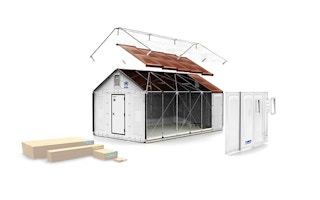Goodbye flimsy tents and hello solar-powered modular shelters. The Ikea Foundation, the Refugee Housing Unit and the United Nations High Commissioner for Refugees (UNHCR) have recently unveiled a new type of housing that refugees and internally displaced people around the world can call home.
To continue reading, subscribe to Eco‑Business.
There's something for everyone. We offer a range of subscription plans.
- Access our stories and receive our Insights Weekly newsletter with the free EB Member plan.
- Unlock unlimited access to our content and archive with EB Circle.
- Publish your content with EB Premium.
Instead of sleeping in canvas tents typically issued by the United Nations and which only last for six months depending on weather conditions, this marginalised sector will soon have a dignified and secure housing alternative.
Refugees are classified by the UN agency as people fleeing due to persecution and fear of violence, conflict, natural disaster, among other reasons, and they live in camps for over 12 years on the average.
Internally displaced persons (IDPs), on the other hand, are those who have not crossed international borders to find sanctuary but have remained within their home countries. They are equally vulnerable and also take years to return to their places of origin, if at all.
There are around 44 million refugees and IDPs around the globe. According to the UNHCR, a majority of the 14.9 million people who became internally displaced in 2011 were in Asia, and all because of natural disasters. By way of comparison, in that same year, Tokyo’s population was around 13.2 million.
But unlike the well-off megacity, the IDPs and refugees’ need is simply to have a roof over their heads during this time of personal upheaval, says Olivier Delarue, head of the UNHCR Innovation initiative, which the Ikea Foundation helped to establish.
This new housing, designed by Swedish designers of the emergency shelter group Refugee Housing Unit (RHU), will provide just that starting, with the Somali refugees in Ethiopia. The housing is still in the beta testing stage and by trying it out in the field, the UNHCR Innovation team said, partner organisations will be able to adjust and rethink the model to better suit the refugees’ needs.
Currently, the housing unit is a modular shelter composed of four parts: the RHU frame, panels, PV system and shade net. The size is 17.5 square metres or about double the area of a traditional refugee tent, and can comfortably fit a family of five.
Like an Ikea product, the housing unit is well designed, functional, easy to transport and assemble and cost-effective.
The RHU frame is a self-supported steel skeleton to which the lightweight yet strong plastic wall and ceiling panels will be attached. It is a durable structure that is said to last up to three years. As a result, there is less energy used to make and replace the short-lived tents every so often. Also, the lightweight components make it more economically and environmentally efficient to ship the units to different locations worldwide.
Now aside from the sturdier shelter, refugees and IDPs will also benefit from the photovoltaic system that can be integrated into the panels or the shade net. The PV system, which is comprised of a solar panel and portable LED with battery and USB power output, gives them much needed electricity and light, saving them from spending their meagre incomes on candles or kerosene.
As for the unusual USB port feature, this is intended for charging mobile phones - a staple even in refugee or relocation camps.
The last component, the shade net, is an external screen that provides 70 per cent solar reflection and cooling during the day and helps lessen radiated heat loss at night or in cold climates.
Currently, the new shelters cost $10,000 to produce but the intent is to bring the cost down to less than 10 per cent of the value when the final design of the houses goes into mass production. This is the same process Ikea does to drive down its product prices.
“Just as Ikea looks for innovative ways to create a better everyday home life for many people, the Ikea Foundation is looking for ways to create a better everyday life for poor families who have lost their homes and everything familiar to them,” said Per Heggenes, Ikea Foundation chief executive officer.
For Johan Karlsson, RHU project manager, the outcome of the project so far is due to the success of the public-private partnership. He said, “We share a genuine interest and understanding of innovation, and we all bring unique resources and skills to the project. The Ikea Foundation provides funding and management support, UNHCR brings the know-how and field experience, while we and our private and academic partners carry out the hands-on development of the product.”
It is a sentiment shared by Delarue as well. “Companies have never before helped improve refugee shelters the way Ikea Foundation has. By introducing us to the Refugee Housing Unit, the Foundation enabled two organisations to share each other’s expertise and experience to create a better shelter, which the UNHCR is now testing in the field.”










